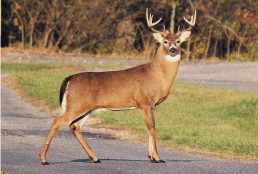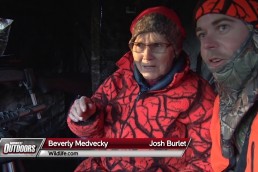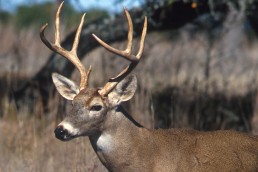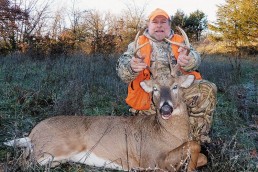Deer Don’t take a Lunch Break
SHARE THIS POST
Hunters are notorious for being predictable. For years we have invaded deer habitats during early morning. We take a break for lunch then assault the woods throughout the afternoon. And if we think deer don’t tune in to our routines, we’re not being observant.
Deer don’t take a break from their intentions from 11 a.m. through 2 p.m. Deer don’t lie down and wait on us. Hunters, on the other hand, can develop patterns of laxity and are void from deer habitats as they refuel with food. Without a doubt, this is a prime time for bucks to search does.
Deer hunters have patterned themselves to hunt from daybreak, then again just before dark. Most hunters concentrate upon these two times that have been etched into our subconscious. But when excessive hunting pressure and rut intensity impacts deer movements, bucks will surprisingly remain active from late morning through early afternoon (10 a.m. to 2 p.m.). Hunters typically spend these hours eating and socializing. There’s no doubt these are great times to hunt because of the whitetail’s habitats. But there are reasons hunters should skip lunch and remain in the woods, especially when the bucks are pursuing estrus does. But it’s also a fact: During the abnormalities of the rut frenzy, bucks move for reasons that aren’t always predictable.
I can still visualize my late uncle sharing detailed stories of his Pennsylvania deer hunts when he was a young man. Although he carried a rifle, when he entered the woods, he hunted until last legal light. He shot several bucks throughout his hunting years. But what sparked my curiosity was that most of his bucks were shot when everyone else was at lunch. That was 40 years ago.
The same truth applies today.
Humans are afflicted with a lack of patience. This makes it difficult to hunt all day. Sometimes, it’s not always possible for hunters to be afield the entire day because of personal schedules. But whenever we’re not hunting, we’re missing out on big buck movements. When hunters leave the woods late morning and don’t return until early afternoon, deer become responsive to a lack of human presence. Besides, when most hunters take a lunch break—and if you’re hunting—your chances of encountering traveling bucks increase. We wait months to tag a mature buck. To leave the woods for a lunch or social break defeats our objectives. Why not carry a snack with you and forget about telling your buddies the details of your day until you return back to hunting camp at last light?
Deer are super sensitive to hunting pressures and probably lay low while hunters canvass their habitats. It’s suggested that this is a prime reason bucks back off from movement, even during the rut. High-noon hunting has never been a chosen time of the day for the majority of hunters. Eating a large lunch, socializing, or maybe a taking a quick nap at noon can also make you lethargic. Visit a restaurant while at lunch, and you will soak up numerous human odors. All the while, our whitetail quarry is still on a roll.
Deer don’t go to lunch at high noon. They are still active, especially during the mating ritual, which usually coincides with hunting season. Biologists have learned that during hunting season deer move for logical reasons: hunger, water and pursuing does to breed with.
Are you enjoying this post?
You can be among the first to get the latest info on where to go, what to use and how to use it!
Within the whitetail social order, many humans believe midday is not normally a productive time for deer movements. So hunters pursue deer early and late. Why? Because humans have always believed this is the best time to tag a deer. But mature bucks are quite different than the average deer. They do their own thing and will travel whenever they encounter the least hunting pressure from hunters. Even during the nonstop activities of mating activities, bucks will still remain secretive, often dogging their does into dense habitats, out of view of hunters. I’ve often wished I could evaluate and determine the mental process of a mature buck—it would make it much easier to tag the big ones. But, as human hunters, we must follow their lead to capitalize on their activities, regardless of the time of day.
It’s not unusual for hunters to learn the hard way.
On a pleasant late November day several years ago, our group of gun hunters stopped for lunch at our lease house. We were enjoying lunch at the kitchen table. While we discussed our morning hunt at 12:15 p.m., one hunter noticed a buck loping up from the creek bottom, not 50 yards from the kitchen window. Sitting on our rumps, guns not available, we watched the buck pass along the edge of the yard and cross the road into a pine grove. Our routine for lunch and socializing kept us from scoring on a dandy buck.
Preoperational diversity—is that another hunting tool? Maybe it’s time to change our hunting schedules. If you’re not normally an all-day hunter, just for a few days each year, instead of hunting from daylight until 11 a.m. and then getting back in the woods from 2 p.m. until dark, make a change. Take a chance; try something new. If you enter the woods at 9 a.m. and stay at least until 3 p.m., you might just meet the best buck you’ve ever seen. It’s worth a try to change your schedule because deer can and do learn how to pattern a hunter’s activity times.
Now’s a good time to access what motivates deer to become active during midday. Obviously, hunger and thirst are prime reasons. During the rut when bucks never seem to rest, estrus does keep the bucks on the run. But weather is also an influential factor, and, possibly, the moon phases may stimulate a buck’s internal mechanisms. It’s believed, according to studies, that three days before a full moon and three days after are very active times for deer. And, during the unpredictable activities of the rut, this might be factual. Therefore, midday during these specific days is a prime time to be afield during high noon because bucks don’t abide by time and aren’t opposed to roaming aggressively while you’re at lunch. Again, try converting from 11 a.m. to 1 p.m. for new opportunities.
Hunters are human and often find it uncomfortable to spend an entire day afield. Hunters can develop patterns of hunting: We take a break at high noon and then get back in the woods until late afternoon. Deer appear to understand this routine. When hunters leave the woods for high-noon social time, deer move with comfort. And, if we aren’t hunting the high-noon lull, we just might miss shooting the best buck we’ve ever seen.
Deer will move throughout the day. Be an all-day hunter.
MWO
SHARE THIS POST
Did you enjoy this post?
You can be among the first to get the latest info on where to go, what to use and how to use it!
Bob Grewell
Bob “Greenie” Grewell has written about and photographed the outdoors for 40 years. He’s travelled throughout the U.S., Canada, the Arctic Circle, as well as Germany and Denmark. He has written a book on hunting dogs and contributed articles and photography to others. He currently focuses on deer and turkey articles, and wildlife photography.




Great read for hunting overall. I agree, it should be read at the beginning of every season. Never forget the basics! Thanks.
Hey Bob!
Thanks for sharing this fantastic post! This is so chock full of useful information. I agree with you this piece will help when hunting deer.